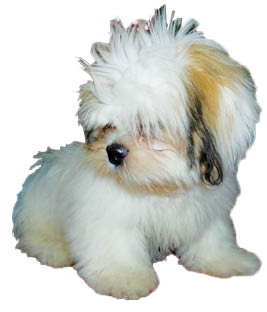Originating in the villages near the sacred city of Lhasa, the Lhasa Apso is one of the three dog breeds from Tibet (the other two being the Tibetan Terrier and the Tibetan Spaniel). In Tibet, the Lhasa is known as the ‘Abso Seng Kye’ or the Bark Lion Sentinel Dog. As the name implies, the Lhasa was bred to be a guard dog. Since larger mastiff-type dogs were used to patrol and protect outdoor perimeters, the Lhasa was given the responsibility of protecting the inside of homes. This included the homes of the privileged classes as well as the Dalai Lama. During a trip to Tibet in the 1930’s, an American named C. Suydam Cutting arranged an audience with the Dalai Lama. They became friends and a pair of Lhasas were given to Cutting as a gift from the Dalai Lama in 1933. This gift resulted in the establishment of the Lhasa Apso in the United States!
 Appearance
Appearance
The Lhasa is a small dog with a tail that curls up over the back. The Tibetans’ hardscrabble existence left little in the way of comforts for their animals. Thus, the Lhasa was developed more by circumstance than by design. Its well-muscled, compact body is heat-preserving; its weatherproof coat insulates the Lhasa against all weather; its short legs give it the agility to manoeuvre the mountainous landscape of Tibet; the hair that covers the eyes, shields them from the wind and bright sunlight. According to the breed standard, the dense, straight, floor-length coat is parted from the tip of the nose to the back. The Lhasa coat comes in a variety of colours, including, sandy, honey, slate, smoke, black, white, brown, dark grizzle or parti-coloured. The adult Lhasa stands 10 to 11 inches at the shoulder and weighs about 15 to 18 pounds.
Personality
The harsh climate of Tibet has led to the development of a hardy and vigorous dog. The breed is highly intelligent and seems to have a sixth sense in distinguishing friends from strangers. Aloof and wary of strangers, the Lhasa quickly becomes friendly and outgoing when he gets to know you.
As loving and affectionate as the Lhasa can be, it is a tough, independent breed and expects to live by its own rules. Extremely devoted to family, they tend to be one-person dogs and are not very tolerant of small children. They are best suited to homes with older children who will handle them carefully. The Lhasa happily lives with other dogs, as long as human companionship is provided.
Trainability
The Lhasa is generally obedient and can be easily trained with love and affection. Some Lhasas tend to be strong willed and have some difficulty following commands. They will eventually do what is asked but may need to take a little time to think about the instructions first. Their independence can lead to problems with dominance/aggression, but with firm and loving discipline, this can be prevented. Its innate wariness of strangers can turn into aggression if not checked at a young age. Early and continual socialisation is a must for every Lhasa Apso.
 Health And Care
Health And Care
Lhasa owners must be avid groomers if they want the dramatic Lhasa coat. The dog needs a bath every one to two weeks and brushing every other day to prevent tangles and mats. For the time-strapped owner, getting a professional groomer to clip the coat short, may be a more convenient option. In any case, the hair on the back of the paw pads should be trimmed regularly and the ears cleaned frequently. Health conditions common to Lhasa Apsos include entropion (a turning outward of the eyelid), progressive retinal atrophy (loss of retinal tissue that impairs vision), congenital kidney ailments, atopy (an allergic skin reaction), intervertebral disc protrusion (causing neck and back pain), and patellar luxation (dislocated kneecap). A healthy Lhasa Apso lives between 12 to 15 years.
- Cracking The Canine Contentment Code: What Makes Dogs Happy - 10 August2024
- The Dark Side Of Pampered Pets: Is Your Kindness Harming Your Dog? - 16 March2024
- Kids And Preventing Dog Bites - 18 March2023

These are some of the most loyal and loving dogs one might come across. A wonderful read.